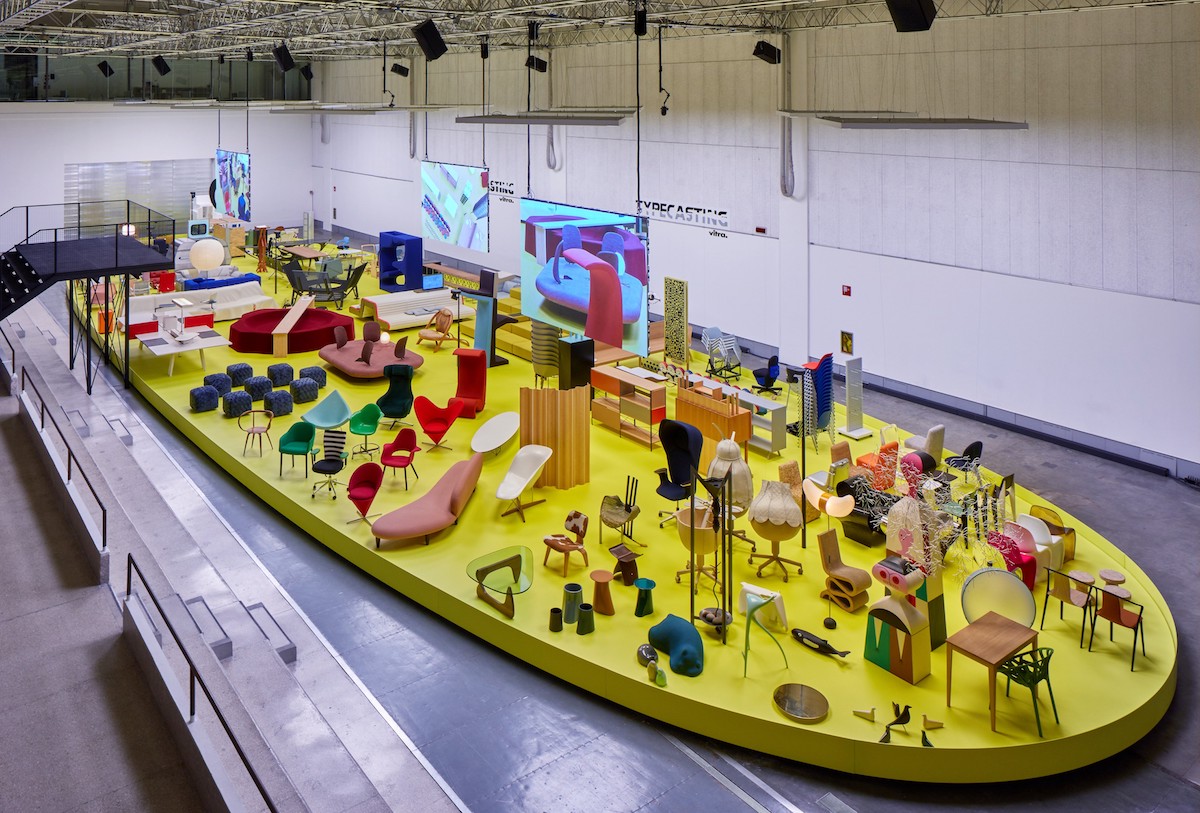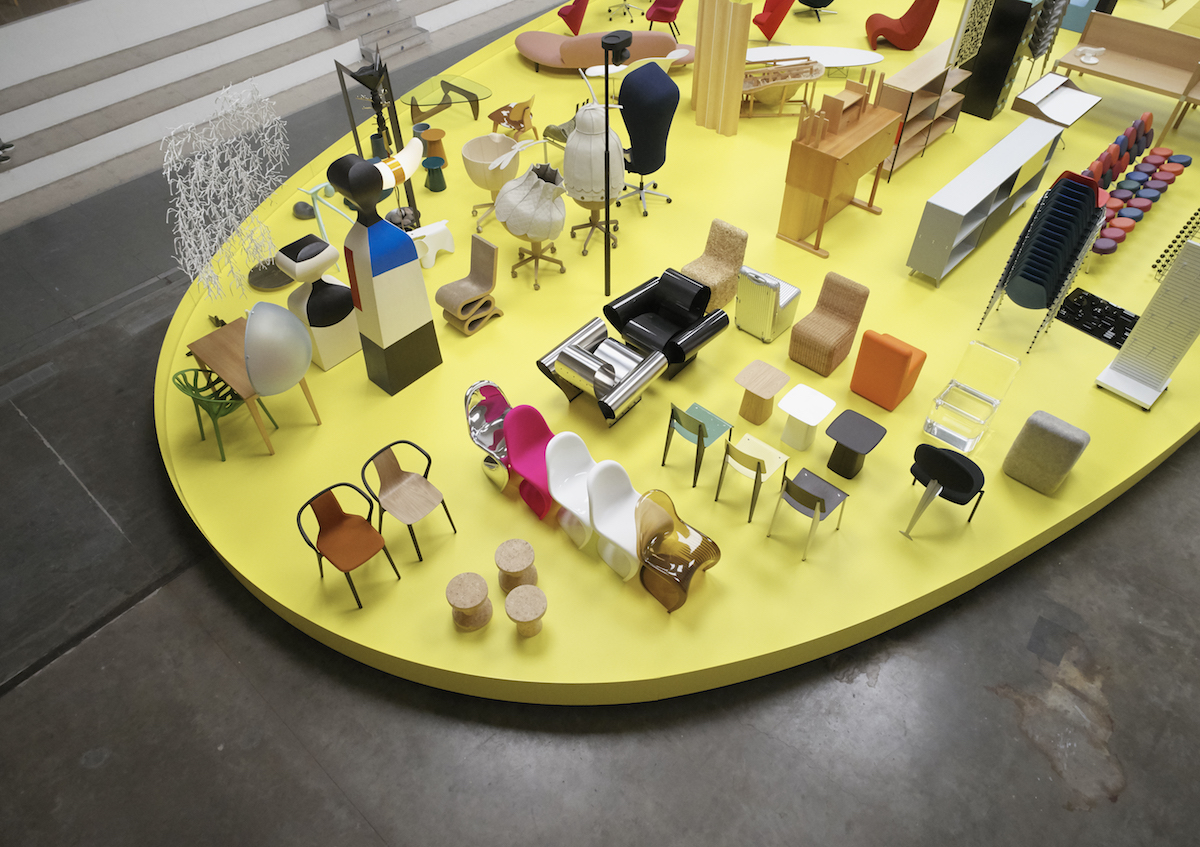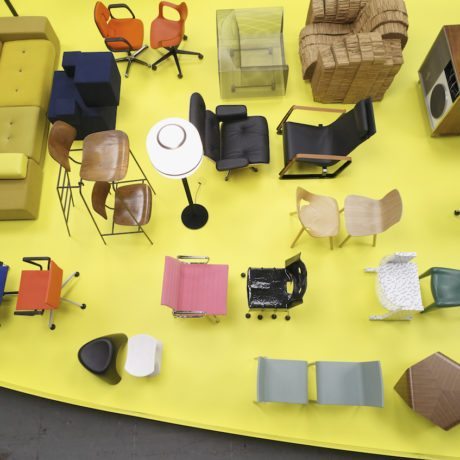 A furry collection of 9×9 ottomans wriggle across a grid of perforations in a stand seemingly of their own volition. Behind them, a peculiar hybrid of chair and couch—fashionably hinging between pink and purple (pale fuchsia is the new millennial pink, haven’t you heard?)—is flanked by Ronan & Erwan Bouroullec’s cavernous burgundy Lake (2018) and a two-tone diving-board-style chair entitled Social Sculpture (Studio Makkink & Bey, 2018). This is the bizarre, anthropomorphic future of communal space.
A furry collection of 9×9 ottomans wriggle across a grid of perforations in a stand seemingly of their own volition. Behind them, a peculiar hybrid of chair and couch—fashionably hinging between pink and purple (pale fuchsia is the new millennial pink, haven’t you heard?)—is flanked by Ronan & Erwan Bouroullec’s cavernous burgundy Lake (2018) and a two-tone diving-board-style chair entitled Social Sculpture (Studio Makkink & Bey, 2018). This is the bizarre, anthropomorphic future of communal space.
Typecasting, organized by the Vitra Design Museum and curated by the French designer Robert Stadler on behalf of Salone del Mobile 2018, offers both a look at the future of design and the future of humanity. Assembling 200 furniture items from Vitra’s archive, and featuring prototypes and one-off editions by artists, designers and architects including Frank Gehry and Scott Burton rarely seen since their debut in 1987, Stadler responded to the museum’s blithe brief to create a “panorama” of Vitra’s collection. “Typecasting stretches and unites the past, present and future of Vitra,” says Stadler, “While reflecting, without judgement or hierarchy, the stereotypes we use to label ourselves and each other.”
Known for his sharp, stylized work that bleeds across installation, exhibition and product design, the Austrian-born Stadler takes an incisive approach to Vitra’s collection which responds to the architectural history of La Pelota and critiques the sociology of design fairs in a single stride. Entering into the old sports stadium, located centrally in the heart of the city’s famous artists’ quarter of Brera, Typecasting emerges as a preppy, combative exhibition which borders on design-world exhibitionism. Yet its elliptical, lemon-yellow stage allows three different levels of critical distance from the characters on show. “We are presenting objects as characters,” explains Stadler. “They are saying as much about us as we are about them.”
“‘We are presenting objects as characters. They are saying as much about us as we are about them”
The stereotypes are so accurate it’s almost painful. Skipping over the Beauty Contestants and Compulsive Organizers sections, Charles and Ray Eames’s iconic DCW Plywood (1945/46) is nearly swallowed up beneath a thick layer of boho chic cowhide upholstery as part of the Dreamers section. A Swiss cheese plant and fiddle fig tree sit nearby in equally stylish pots—they’re part of an unrealized project by Maria Jeglinska titled The Portable Landscape (2018).
A visibly awkward procession of coupled-up furniture lines the ranks of Dating Site Encounters. While some, like Maarten Van Severen’s 0.03 Stacking and 0.03 Non-Staking (1999) mirror each other almost perfectly, there’s an unexpected but totally legit love connection between Frank Gehry’s raggedy Grandpa Chair (1987) and Shiro Kuramata’s weightless steel mesh counterpart, How High the Moon (1986). “Dating Site Encounters embodies the mismatching and occasionally serendipitous connections that have become the new normal,” says Stadler. The pairings are sweet and unruly, and each character’s personality is somehow magnified by the contrast or complement. Especially with Jasper Morrison’s pared-back, deep blue Soft Modular Sofa (2017) and Hella Jongerius’s lovingly patchwork Vlinder (2018), which appear to lay side-by-side like that just-married couple for whom it all began with a miraculous right swipe, does the anthropomorphic inspiration—and sagacious social musing—of Typecasting become most apparent.

Wedged between the fanciful Dreamers and Compulsive Organizers is, appropriately enough, the Slashers: which embodies the chaotic lifestyle of the modern-day freelancer. Between Ron Arad’s flappy metal Well Tempered Chair (1986/87) and Pantone’s assembly line of many-coloured chairs (from fluorescent pink to totally translucent) there’s an immediate sympathy with the schizophrenic “cupcake caterer/designer/Uber driver” tagline that’s par for the course for the post-recession career.
“If there is a single design object that embodies the existential crisis of millennials, it’s the sofa”
Circling back to Communals in the dead-centre of the stadium, these enigmatic characters start to emerge as the group tying this whole rodeo together. The trendy pale fuchsia Hybrid is by Stadler himself, as part of a series of new models for communal living, which take up the sofa as their primary inspiration.
Moving from the private living room staple to the centrepiece of live-work enterprises like WeWork and Second Home, Communals references the shifting typology of communal space. If there is a single design object that embodies the existential crisis of millennials, it’s the sofa: as a surrogate dinner table or desk in a cramped studio apartment; a freelancer’s desk-of-choice; a bed in our couchsurfing and Airbnb sharing economy. We eat, sleep, work and live on this multi-use object. Ironically, says Stadler, the couch also still manages to latch onto its older, more noble symbolism: bourgeois domestication.

“We all remember buying our first sofa. It’s a critical moment in your life where you start to be a grown-up,” he suggests. For as much as the Communals emphasize the present trend toward living and working together, they are also some of the most dynamic and distinguished pieces in the show. They reflect our need to establish our unique identity and the heightened obsession with self-fashioning in the era of shared and mixed-use everything. There is a camaraderie, but also a competitiveness among them, that references that anxiety as well as paying tribute to the architectural history of La Pelota as an old sports stadium. This is a sentiment that’s also echoed through the layering of the three viewing platforms: level zero, metre-high benches and a panorama view from the top of a set of black stairs: the most literal interpretation of the design brief for a panoramic view into Vitra’s world.
Three screens with slick, commercial footage featuring product zoom-ins and special cuts loom over the motley collection of furniture. It looks highly edited, but there’re actually four cameramen and a director manning the shots in real time. Looking back to the installation, the four black stalks sporting cameras—so sleek they give the furniture a run for its money—sprout up from the lemon-yellow podium. Their backs are covered with an epic grid of jarring, blinking lights: “for fans of kitsch”, says Stadler. As for the footage? “It looks unreal, but it’s actually more real than reality,” he suggests. As the cameramen zoom in fixedly on details and lovingly trace the curves in plush sofas and gangly stacks of chairs, its deeper purpose starts to emerge. The visually arresting live cam of “hyper-reality” keeps us lingering around the crazy and true stage set a little longer, encouraging us to take a second, third and fourth survey of its eclectic characters, uncovering more of our own typecasting habits in the process.






